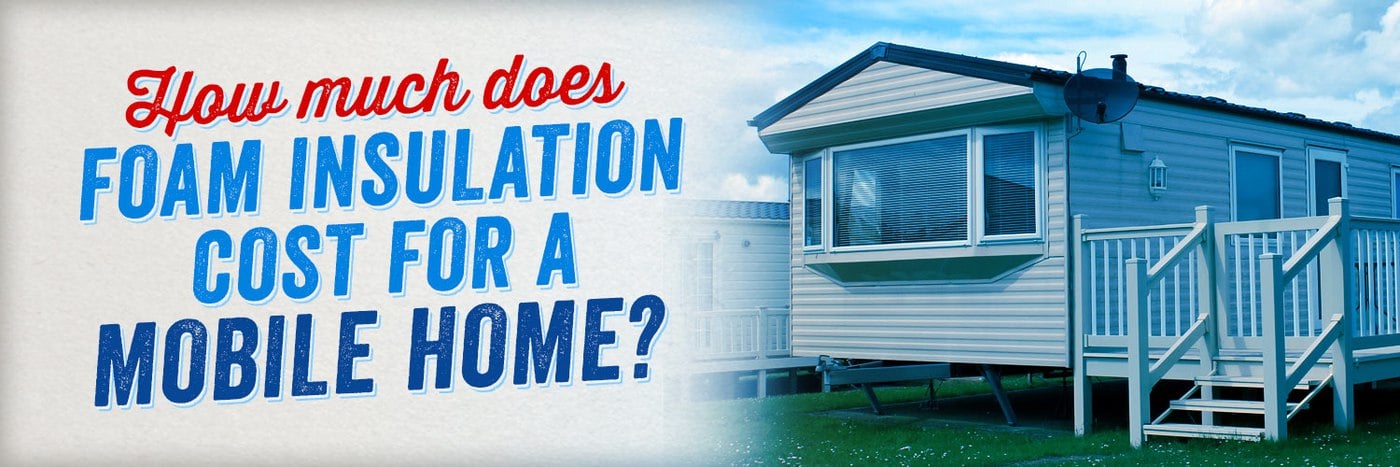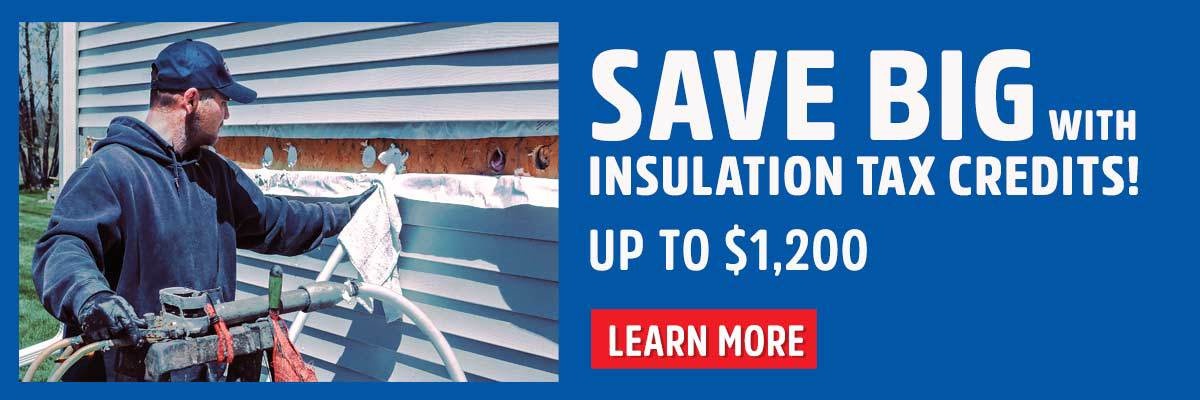How Much Does Foam Insulation Cost for a Mobile Home in 2026? (Prices/Rates/Factors)
injection foam insulation | spray foam insulation | mobile home insulation


You’re tired of dealing with high monthly energy bills and an uncomfortable house, and you’re considering spray foam insulation, but you need to plan a budget.
Wondering how much it costs to insulate your mobile home with foam? Here's everything you need to know.
The cost to insulate your mobile home with foam insulation will vary depending on several factors, from the size of the house to the size of the areas to be insulated.
RetroFoam of Michigan has insulated thousands of homes across Michigan’s Lower Peninsula and the greater Toledo area. We have experienced crews that are specially trained to inject and spray foam in your home, ensuring it is an energy-efficient and comfortable space for you and your family.
Because every mobile home isn’t created equal, the prices we give in this article are a range. The best way to get an exact price for foam insulation cost for mobile homes is to have one of our project managers out to provide you with a free, no-pressure quote.
Key Points:
• Average cost: Insulating a mobile home with foam from top to bottom (ceiling, walls, and skirting) typically ranges from $5,900 to $8,900, depending on the size and scope of the project.
• Size matters: Single-wide mobile homes generally cost less to insulate than double-wides because they require fewer materials and less labor.
• Foam types used:
• Injection foam is used for enclosed wall cavities.
• Spray foam is used in open areas like the ceiling, rim joist, and around the skirting.
• Project timeline: Most full mobile home foam insulation projects are completed in about one day, with active removal and installation typically taking 3 to 5 hours.
• What's included: Your project price includes removing old insulation, installing foam, protecting and cleaning the work areas, and filling out rebate paperwork with your energy provider.
• No surprise charges: The quote you sign is the final cost -- there are no hidden fees once the project is completed.
• Rebates: Michigan homeowners may qualify for utility rebates for qualifying insulation upgrades.
• Support and warranty: RetroFoam of Michigan offers a free, no-pressure consultation, a concierge program to guide you through the process, help with financing options, and a lifetime transferable warranty on materials and workmanship for as long as the home stands.
How Much Does it Cost to Insulate a Mobile Home with Foam Insulation?
The cost to insulate your mobile home will depend on the area's square footage.
The average spray foam insulation cost for a mobile home from top to bottom is between $5,900 to $8,900. This covers the ceiling, walls, and skirting.
What Factors Determine the Total Cost of Spray Foam Insulation?
Several key factors influence the total cost of spray foam insulation for your mobile home.
Understanding these factors can help you estimate your budget more accurately.
Size of the Area to Be Insulated
The size of your mobile home plays the biggest role in determining the cost.
- Single-wide mobile homes are smaller and typically less expensive to insulate.
- Double-wide mobile homes require more materials and labor, increasing the overall price.
Type of Spray Foam Used
The choice between open cell spray foam and closed cell spray foam affects the cost.
- Open cell spray foam is usually more affordable and ideal for areas where flexibility and sound dampening are priorities.
- Closed cell spray foam is more expensive but provides greater structural support and higher R-Value, making it a better choice for extreme climates or exterior applications.
Additional Factors to Consider
- The complexity of your home's design may impact labor costs.
- Regional pricing differences and material availability can also play a role.
Foam Insulation Installation Process for Mobile Homes
Installing foam insulation in a mobile home typically takes one to two days, depending on the condition of your existing insulation.
Here's a breakdown of how we insulate the ceiling, walls, and skirting of your mobile home.
Insulating the Ceiling of a Mobile Home
The process for insulating a mobile home ceiling depends on its structure.
- Paneling Ceilings: If your mobile home ceiling is panelled, it may not support the weight of spray foam.
- Drywall Ceilings: For solid drywall ceilings, the installation process is straightforward. Crews will:
- Remove any old insulation.
- Cut strips into the drywall to access the stud cavities.
- Spray foam into the cavities.
- Replace the drywall and apply a rough patch of mud. (Note: Homeowners are responsible for sanding and painting the patched areas).
- Drop Ceilings: For drop ceilings, panels are removed, foam is sprayed, and the panels are replaced.
Insulating the Walls of a Mobile Home
The wall insulation process varies depending on your siding type and installation direction:
- Vertical Aluminum Siding: Since this siding isn't easily removed:
- Crews drill 1 1/2-inch holes to inject foam insulation into the stud cavities.
- The holes are sealed with caulk to maintain the siding's appearance.
- Horizontal Aluminum or Vinyl Siding: For these common siding types:
- Crews remove a strip of siding to drill holes between the stud cavities.
- After injecting foam, the siding is replaced, and any excess foam is cleaned up.
- Wood Siding: Depending on the condition of your wood siding:
- It may be removed to follow the same process as vinyl or aluminum siding.
- If removal isn't possible, crews drill directly into the wood and seal the holes with tapered wood plugs.
- Brick Exterior: No bricks need to be removed:
- Installers drill small 5/8-inch holes in the mortar joints to inject the foam.
- The holes are re-mortared for a seamless finish.
Insulating the Skirting and Rim Joist
The skirting and underside of your mobile home are treated similarly to a crawl space:
- Crews remove old insulation.
- Spray foam is applied to the skirting (the "walls" of the space) to seal air leaks and improve energy efficiency.
- This method reduces drafts, deters pests, and protects your mechanical systems beneath the home.
Types of Foam Insulation Materials Offered
When an entire mobile home is insulated with foam, crews use spray foam and injection foam.
It comes down to the areas that need insulation and whether the cavities are open or enclosed.
Injection foam will be used in the enclosed walls, while spray foam will be used in the rim joist, ceiling, and around the skirting.
What Other Services Are Offered When Insulating Your Mobile Home?
- A free estimate with no pressure sales tactics.
- Free concierge program that leaves the homeowner with a go-to person to answer all of their questions from start to finish.
- Help to complete financing for the homeowner. It will be important to discuss this with your insulation contractor, as some lenders don't offer loans for land leased to others. There are lenders who do have loan options in this scenario.
- Preparation before installation includes removing old insulation and covering items in the home to keep them clean and protected.
- Cleanup after installation so the mobile home looks just like it did before the work began.
- Filling out rebate paperwork with the homeowner's energy provider.
- A lifetime warranty that covers workmanship as well as materials. This lifetime warranty lasts as long as the home does and is transferable if the house is sold.
How Long Does it Take to Insulate an Entire Mobile Home?
In most cases, an entire mobile home can be insulated in just one day.
The day of the installation is spent removing any old insulation underneath the mobile home. Then, the foam insulation is installed.
Removal of old insulation, spraying, and injecting foam insulation can take 3 to 5 hours.
Additional Fees, Taxes, and Costs
There are no additional fees or hidden costs once your project has been completed. The quote you sign and agree to is the final cost to insulate your mobile home.
Unlocking Savings: Foam Insulation Rebates and Tax Credits for Michigan Homeowners
Let's first clarify the distinction between rebates and tax credits.
Rebates are like cash rewards given to homeowners who accomplish specific energy-efficient upgrades.
On the other hand, tax credits directly reduce your tax liability when you invest in energy-efficient home improvements.
Michigan homeowners can choose from several types of rebates and tax credits.
The standard mail-in insulation rebate is for those insulating a single area of their home, with rebates ranging from $50 to $250, depending on the project's size. Utility providers like Consumers Energy, DTE, SEMCO, and Michigan Gas and Utilities are your go-to sources for these rebates. If you're insulating at least two areas of your home, you may qualify for the home performance rebate, which ranges from $400 to $1,100.
The Inflation Reduction Act, which supports energy-efficient home improvements, offers a tax credit of up to $1,200 annually for individual insulation or other energy-efficient upgrades.
This tax credit is available until December 31, 2025. To access this tax credit, you'll need to complete IRS Form 5695 and include a copy of your contract with RetroFoam of Michigan.
It's essential to note that eligibility for these rebates and tax credits may require consultation with your energy provider and a tax professional to ensure your work qualifies.
Why Choose Foam Insulation for Mobile Homes?
Foam insulation provides superior energy efficiency, air sealing, and comfort for mobile homes.
Whether you're addressing drafty ceilings, uninsulated walls, or an exposed skirting area, spray foam can transform your home while reducing your energy bills.
If you live in Michigan’s Lower Peninsula or the greater Toledo area and would like to schedule a free in-home estimate, give us a call at 866-900-3626 or fill out the form on our website.
Related Articles
How Air Sealing Insulation in Your Home Works Like Your Airtight Cooler
Foam vs Fiberglass: Which Insulation is Best for My Mobile Home?
Mobile Home Insulation Problems: Four Issues to Avoid
Frequently Asked Questions About Mobile Home Foam Insulation Cost
How much does it cost to insulate a mobile home with foam?
For more mobile homes, insulating the ceiling, walls, and skirting with foam typically costs between $5,900 and $8,900.
Your exact price depends on the size of your home and the areas you choose to insulate.
What factors affect the total cost of spray foam insulation in a mobile home?
The biggest factors are square footage, whether your home is single-wide or double-wide, the type of foam used (open cell vs. closed cell), and the complexity of the home's design.
Regional material and labor costs can also influence the final price.
What's included in the quote from RetroFoam of Michigan?
Your quote includes:
- Removal of old insulation where needed
- Installation of spray foam or injection foam in the agreed areas
- Protection of your belongings during the project
- Cleanup so your home looks like it did before the work
- Help completing rebate paperwork with your energy provider
There are no additional fees or hidden costs beyond the price you agree to in your contract.
Are there rebates available for insulating my mobile home?
Yes, many Michigan homeowners qualify for:
- Utility rebates (often $50 to $250 for single-area projects, and $400 to $1,100 for home performance rebates when at least two areas are insulated)
You'll want to check with your energy provider to confirm your eligibility.
How long does it take to insulate an entire mobile home with foam?
Most full mobile home projects are completed in one day.
The removal of old insulation and installation of spray and injection foam typically takes 3 to 5 hours, depending on the condition of the existing insulation and the size of the home.
How do you insulate different parts of a mobile home?
- Ceiling: Crews may remove panels or cut into drywall to access cavities, remove old insulation, spray foam, and then patch the openings. Drop ceiling panels are removed and replaced after spraying.
- Walls: Depending on your siding, crews either remove strips of siding or drill small holes to inject foam into wall cavities, then seal or plug the holes and replace the siding.
- Skirting and rim joist: Old insulation is removed, and spray foam is applied to the skirting and rim joist area to seal air leaks and protect mechanicals.
What types of foam insulation are used in mobile homes?
RetroFoam of Michigan typically uses injection foam in enclosed wall cavities and spray foam in open areas like the ceiling, rim joist, and skirting.
The specific foam type is chosen based on whether the area is open or enclosed and the performance needed.
Will my home be a mess after installation?
Crews prepare the space, cover items to keep them clean, remove old insulation as needed, and clean up when the job is done.
The goal is for your mobile home to look just like it did before, only more comfortable and energy efficient.
Is financing available for mobile home foam insulation?
Yes, RetroFoam of Michigan can help connect you with financing options.
It's important to discuss your situation with the project manager, as some lenders have different rules for mobile homes on leased land. There are lenders who do offer loan options in this scenario.
Is the warranty really for the life of the home?
Yes.
RetroFoam of Michigan offers a lifetime warranty that covers both materials and workmanship for as long as the home stands. The warranty is also transferable if you sell the home, which can be a selling point for future buyers.
About Amanda Emery
Amanda previously has worked as a breaking news and crime reporter, TV news producer, and editor in Flint and Detroit. Throughout her career as a journalist, she has won several awards from The Society of Professional Journalists - Detroit Chapter and the Michigan Press Association. As part of the RetroFoam of Michigan family, Amanda uses her experience as a journalist to write content that will help educate homeowners on the benefits of foam insulation. When Amanda isn’t writing, she’s spending time with her husband and rescued huskies. She also loves knitting, making art, cooking, and hosting dinner and a movie night for friends and family.




